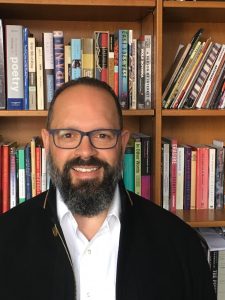Associate Professor Pablo Peschiera (’93) teaches many different courses, but his heart lies split between two: poetry writing courses and literary translation courses. Pablo writes his own poems in English, and he translates from Spanish to English. His ongoing translation project is on the work of Manuel Ramos Otero (1948 –1990), the Puerto Rican poet, writer, playwright, director, and professor. Otero’s work is passionate and full of experimentation. The below piece—about how Pablo thinks of translation, memory, and language—is the jumping-off point for an upcoming colloquium titled “How I Learned to Trust Myself” at 3:30 pm, January 25th, in the Fried-Hemenway Auditorium of the Martha Miller Center at Hope College. It is free and open to the public.
From One Side of the River to the Other

I write poems in English and translate poems and stories from Spanish to English. When we translate, we try to get something from one language into another language. This is like carrying ideas and images across a bridge, from, in my case, the Spanish side of a river to the English side. The word “translate” comes from the Latin words meaning “across” (trans) and “carry” (latus). The bridge in this metaphor is the translator’s imagination.
I’m going to extend this river and bridge metaphor a bit more, because I find it useful in explaining what a translator does. When I translate, my carrying-across-the-bridge only works one way, from the Spanish side to the English side. It’s like I’m an importer/exporter with a license that only works one way: I can carry across from the Spanish side to the English side, but not in the other direction, from English to Spanish.
I could give it a try, though, carrying a poem or story from English to Spanish, but I know I wouldn’t do a very good job. In Spanish, anything I translate from English just wouldn’t sound right. A native Spanish speaker would get it, but they’d probably laugh at it—and they’d be right to! It would sound silly, often incorrect and off kilter.
I grew up in Kalamazoo, Michigan to which we moved from Peru when I was five years old. English is my native language, which means I spoke it with my friends and in school. At home I spoke Spanish, but not with the same intensity and energy I spoke English. English was the cool language. All the music was in English, the TV was in English, my friends and their families all spoke English—everything was in English. None of my teachers spoke Spanish. Even our high school Spanish teacher only spoke English (but she could read and write Spanish very well—go figure). Translators say “translate into the language of your dreams.” For me, that’s usually English.
English is the language I trust. In English, I believe what I say and what I write, and the words come fluidly, like smooth water rippling over stones. When I cross the bridge from the Spanish side of the river to the English side, I need to trust myself. The bridge is dangerous—which means the imagination is dangerous. No steel girders, stone boulders, or even brick or wood in the imagination. Because the imagination is in the human mind, it’s weak and wears out quickly, as if it’s made of rope. And not even the good stuff, like nylon or poly—not even hemp! It’s cotton sisal, or twine. It rots in the sun and weather and comes unraveled. It needs mending every day. So I need to cross the imagination using the language I know best, the language I trust, which is English.
Don’t get me wrong—I know Spanish well. My accent is usually very good, especially if I’ve been practicing. If I parachuted into a Spanish-speaking country today, I’d have zero problems understanding and making myself understood. If I’m hungry, I say ¿conoces un restaurante bueno por aquí? If I want to buy a lottery ticket, I say ¿dónde puedo comprar un boleto de lotería? I couldn’t argue a case in court, and I couldn’t have a debate about Manichaeism, but most English speakers couldn’t do either in English anyway. So I’d be fine.
What makes me not a native speaker is that I don’t trust Spanish. When I write Spanish the rope bridge feels like it’s unraveling. I might foolishly confuse boda (wedding) for bota (boot), or sagrado (sacred) for sangriente (bloody). Spanish uses gendered articles and nouns: La cancha (the court) is feminine and el maletero (the trunk) is masculine, because words that end in “a” are feminine, and words that end in “o” are masculine. I get those wrong sometimes because there are tons (tons!) of exceptions. When I read Spanish I have no problem with these things—I read fluidly almost as quickly and pleasantly as I do in English.
What it comes down to is art. If I carry a poem across the bridge (a poem is a work of art), I can’t look up words to use while I’m on rope bridge of my Spanish imagination, with its dry rot and frayed knots. I have to concentrate on the destination of the English side. I need to trust the bridge. It’s only made of rope, but at least it’s well mended and strong. It must hold me up. Why? Because the bridge of language hovers over the river, and the river is chaos.